Optimization of the Rheological Properties and Tribological Performance of SAE 5w-30 Base Oil with Added MWCNTs
Abstract
:Highlights
- SAE 5w-30 oil-based nanolubricants were prepared by the addition of MWCNTs in six compositions.
- The tribological and rheological properties of the nanolubricants were measured and compared.
- The flash point, pour point, thermal conductivity, and kinematic viscosity increased whereas the friction and wear decreased with the addition of nanofillers.
- The 0.06 wt.% MWCNT/SAE 5w-30 nanolubricant emerged as the optimum best-performing composition.
1. Introduction
2. Experimental Work
2.1. Materials
2.2. Characterization of the MWCNTs
2.3. Fabrication of the Nanolubricant and Test Equipment
2.4. Tribological Tests
2.5. Pour Point, Flash Point, and Thermal Conductivity Measurements
2.6. Measurement of the Kinematic Viscosity
3. Results and Discussions
3.1. Characterization of the MWCNTs
3.2. Pour Point and Flash Point
3.3. Thermal Conductivity
3.4. Kinematic Viscosity
3.5. Tribological Properties
4. Conclusions
Author Contributions
Funding
Acknowledgments
Conflicts of Interest
References
- Fergusan, C.; Kirkpatrick, A.T. Internal Combustion Engines; John Wiley & Sons: Hoboken, NJ, USA, 2001. [Google Scholar]
- Esfe, M.H.; Afrand, M.; Yan, W.-M.; Yarmand, H.; Toghraie, D.; Dahari, M. Effects of temperature and concentration on rheological behavior of MWCNTs/SiO 2 (20–80)-SAE40 hybrid nano-lubricant. Int. Commun. Heat Mass Transf. 2016, 76, 133–138. [Google Scholar] [CrossRef]
- Mohamed, A.; Khalil, A.M.; Osman, T.; Kamel, B.M. Development and manufacturing an automated lubrication machine test for nano grease. J. Mater. Res. Technol. 2020, 9, 2054–2062. [Google Scholar] [CrossRef]
- Kamel, B.M.; Mohamed, A.; El-Sherbiny, M.; Abed, K. Tribological behaviour of calcium grease containing carbon nanotubes additives. Ind. Lubr. Tribol. 2016, 68, 723–728. [Google Scholar] [CrossRef]
- Kamel, B.M.; Mohamed, A.; El-Sherbiny, M.; Abed, K. Rheology and thermal conductivity of calcium grease containing multi-walled carbon nanotube. Full- Nanotub. Carbon Nanostructures 2016, 24, 260–265. [Google Scholar] [CrossRef]
- Ashour, M.; Mohamed, A.; Elshalakany, A.B.; Osman, T.; Khatab, A. Rheological behavior of lithium grease with CNTs/GNPs hybrid nanocomposite as an additive. Ind. Lubr. Tribol. 2018, 70, 331–338. [Google Scholar] [CrossRef]
- Zhang, X.; Guo, Y.; Li, Y.; Liu, Y.; Dong, S. Preparation and tribological properties of potassium titanate-Ti3C2Tx nanocomposites as additives in base oil. Chin. Chem. Lett. 2019, 30, 502–504. [Google Scholar] [CrossRef]
- Bhaumik, S.; Pathak, S. Analysis of Anti-Wear Properties of CuO Nanoparticles as Friction Modifiers in Mineral. Oil (460cSt Viscosity) Using Pin-On-Disk Tribometer. Tribol. Ind. 2015, 37, 196–203. [Google Scholar]
- Tiruvenkadam, N.; Thyla, P.; Senthilkumar, M.; Bharathiraja, M.; Murugesan, A. Synthesis of new aluminum nano hybrid composite liner for energy saving in diesel engines. Energy Convers. Manag. 2015, 98, 440–448. [Google Scholar] [CrossRef]
- Rezasoltani, A.; Khonsari, M. Experimental investigation of the chemical degradation of lubricating grease from an energy point of view. Tribol. Int. 2019, 137, 289–302. [Google Scholar] [CrossRef]
- Gurt, A.; Khonsari, M. The Use of Entropy in Modeling the Mechanical Degradation of Grease. Lubricants 2019, 7, 82. [Google Scholar] [CrossRef] [Green Version]
- Zhou, Y.; Bosman, R.; Lugt, P.M. A Master Curve for the Shear Degradation of Lubricating Greases with a Fibrous Structure. Tribol. Trans. 2018, 62, 78–87. [Google Scholar] [CrossRef] [Green Version]
- Joly-Pottuz, L.; Dassenoy, F.; Vacher, B.; Martin, J.; Mieno, T. Ultralow friction and wear behaviour of Ni/Y-based single wall carbon nanotubes (SWNTs). Tribol. Int. 2004, 37, 1013–1018. [Google Scholar] [CrossRef]
- Zvereva, E.R.; Khabibullina, R.V.; Akhmetvalieva, G.R.; Makarova, A.O.; Zueva, O.S. Influence of Nanoadditives on Rheological Properties of Fuel Oil. In Proceedings of the International Conference “Actual Issues of Mechanical Engineering” 2017 (AIME 2017), Tomsk, Russia, 27–29 July 2017; Atlantis Press: Amsterdam, The Netherlands, 2017. [Google Scholar]
- Ettefaghi, E.-O.-L.; Ahmadi, H.; Rashidi, A.; Nouralishahi, A.; Mohtasebi, S.S. Preparation and thermal properties of oil-based nanofluid from multi-walled carbon nanotubes and engine oil as nano-lubricant. Int. Commun. Heat Mass Transf. 2013, 46, 142–147. [Google Scholar] [CrossRef]
- Dinesh, R.; Prasad, M.G.; Kumar, R.R.; Santharaj, N.J.; Santhip, J.; Raaj, A.A. Investigation of Tribological and Thermophysical Properties of Engine Oil Containing Nano additives. Mater. Today Proc. 2016, 3, 45–53. [Google Scholar] [CrossRef]
- Saxena, A.; Gangwar, S.; Ghosh, G.K.; Patel, R.K.; Chaudhary, V. Rheological properties analysis of MWCNT/graphene hybrid-gear oil (SAE EP-90) nanolubricants. Mater. Today Proc. 2020, 33, 5313–5316. [Google Scholar] [CrossRef]
- Khalil, W.; Mohamed, A.; Bayoumi, M.; Osman, T.A. Thermal and Rheological Properties of Industrial Mineral Gear Oil and Paraffinic Oil/CNTs Nanolubricants. Iran. J. Sci. Technol. Trans. Mech. Eng. 2017, 42, 355–361. [Google Scholar] [CrossRef]
- Khalil, W.; Mohamed, A.; Bayoumi, M.; Osman, T.A. Tribological properties of dispersed carbon nanotubes in lubricant. Fullerenes Nanotub. Carbon Nanostructures 2016, 24, 479–485. [Google Scholar] [CrossRef]
- Mohamed, A.; Osman, T.; Toprak, M.; Muhammed, M.; Uheida, A. Surface functionalized composite nanofibers for efficient removal of arsenic from aqueous solutions. Chemosphere 2017, 180, 108–116. [Google Scholar] [CrossRef]
- Mohamed, A.; El-Sayed, R.; Osman, T.; Toprak, M.; Muhammed, M.; Uheida, A. Composite nanofibers for highly efficient photocatalytic degradation of organic dyes from contaminated water. Environ. Res. 2016, 145, 18–25. [Google Scholar] [CrossRef] [PubMed]
- Kamel, B.M.; El-Kashif, E.; Hoziefa, W.; Shiba, M.S.; Elshalakany, A.B. The effect of MWCNTs/GNs hybrid addition on the tribological and rheological properties of lubricating engine oil. J. Dispers. Sci. Technol. 2021, 42, 1811–1819. [Google Scholar] [CrossRef]
- Zhang, X.F.; Dong, H.X.; Xu, Z.Y.; Li, K.W.; Qin, M. Synthesis, Physicochemical, and Tribological Characterization of Nano Lubricant Contained Cu Nanocolloid as Additive. Adv. Mater. Res. 2013, 860–863, 1828–1833. [Google Scholar] [CrossRef]
- Emiroglu, M.; Douba, A.E.; Tarefder, R.A.; Kandil, U.F.; Taha, M.R. New Polymer Concrete with Superior Ductility and Fracture Toughness Using Alumina Nanoparticles. J. Mater. Civ. Eng. 2017, 29, 04017069. [Google Scholar] [CrossRef]
- Wang, B.; Pang, B. The Influence of N,N-Dimethylformamide on Dispersion of Multi-Walled Carbon Nanotubes. Russ. J. Phys. Chem. A 2020, 94, 810–817. [Google Scholar] [CrossRef]
- Tijerina, J.T.; Castillo, F.; Leal, J.; Parás, L.P.; Cortés, D.M.; Cruz, C.; García, G.G.; García, P. Nanoparticles of Zn and ZnO as extreme pressure (EP) additives for lubricants. J. Appl. Res. Technol. 2018, 16. [Google Scholar] [CrossRef] [Green Version]
- Yadav, G.; Tiwari, S.; Jain, M. Tribological analysis of extreme pressure and anti-wear properties of engine lubricating oil using four ball tester. Mater. Today Proc. 2018, 5, 248–253. [Google Scholar] [CrossRef]
- Babu, D.; Anand, R. Influence of fuel. In Advances in Eco-Fuels for a Sustainable Environment; Elsevier: Amsterdam, The Netherlands; Central Queensland University: Rockhampton, Australia, 2019; pp. 353–390. [Google Scholar]
- Balakrishnan, J.; Pramila, J. A eminence value of hydrocarbon diesel oil with viscosity density flash point aniline point and distillation. Mater. Today Proc. 2020, 33, 4015–4019. [Google Scholar] [CrossRef]
- Braun, J.L.; Olson, D.H.; Gaskins, J.T.; Hopkins, P.E. A steady-state thermoreflectance method to measure thermal conductivity. Rev. Sci. Instrum. 2019, 90, 024905. [Google Scholar] [CrossRef] [PubMed] [Green Version]
- Hoffmann, J.-F.; Henry, J.-F.; Vaitilingom, G.; Olives, R.; Chirtoc, M.; Caron, D.; Py, X. Temperature dependence of thermal conductivity of vegetable oils for use in concentrated solar power plants, measured by 3omega hot wire method. Int. J. Therm. Sci. 2016, 107, 105–110. [Google Scholar] [CrossRef]
- Guo, W.; Li, G.; Zheng, Y.; Dong, C. Measurement of the thermal conductivity of SiO2 nanofluids with an optimized transient hot wire method. Thermochim. Acta 2018, 661, 84–97. [Google Scholar] [CrossRef]
- Kommandur, S.; Yee, S. A suspended 3-omega technique to measure the anisotropic thermal conductivity of semiconducting polymers. Rev. Sci. Instrum. 2018, 89, 114905. [Google Scholar] [CrossRef]
- Kleizienė, R.; Paliukaitė, M.; Vaitkus, A. Effect of nano SiO2, TiO2 and ZnO modification to rheological properties of neat and polymer modified bitumen. In International Symposium on Asphalt Pavement & Environment; Springer: Berlin, Germany, 2019. [Google Scholar]
- Sajith, V.; Mohiddeen, M.; Sajanish, M.B.; Sobhan, C.B. An investigation of the effect of addition of nanoparticles on the properties of lubricating oil. In Proceedings of the Heat Transfer Summer Conference, Vancouver, Canada, 8–12 July 2007. [Google Scholar]
- Pownraj, C.; Arasu, A.V. Effect of dispersing single and hybrid nanoparticles on tribological, thermo-physical, and stability characteristics of lubricants: A review. J. Therm. Anal. Calorim. 2021, 143, 1773–1809. [Google Scholar] [CrossRef]
- Pourpasha, H.; Heris, S.Z.; Mahian, O.; Wongwises, S. The effect of multi-wall carbon nanotubes/turbine meter oil nanofluid concentration on the thermophysical properties of lubricants. Powder Technol. 2020, 367, 133–142. [Google Scholar] [CrossRef]
- Han, Z.; Fina, A. Thermal conductivity of carbon nanotubes and their polymer nanocomposites: A review. Prog. Polym. Sci. 2011, 36, 914–944. [Google Scholar] [CrossRef] [Green Version]
- Abdullaha, M.A.; Saleman, S.A.; Tamaldin, N.; Suhaimi, M.S. Reducing wear and friction by means of lubricants mixtures. Procedia Eng. 2013, 68, 338–344. [Google Scholar] [CrossRef] [Green Version]
- Chevalier, J.L.; Petrino, P.; Gaston-Bonhomme, Y. Estimation method for the kinematic viscosity of a liquid-phase mixture. Chem. Eng. Sci. 1988, 43, 1303–1309. [Google Scholar] [CrossRef]
- Horowitz, H.J.I.; Chemistry, E. Predicting effects of temperature and shear rate on viscosity of viscosity index–improved lubricants. Ind. Eng. Chem. 1958, 50, 1089–1094. [Google Scholar] [CrossRef]
- Devlin, M.T. Common Properties of Lubricants that Affect Vehicle Fuel Efficiency: A North American Historical Perspective. Lubricants 2018, 6, 68. [Google Scholar] [CrossRef] [Green Version]
- Syahrullail, S.; Ani, F.N.; Golshokouh, I. Wear Resistance Characteristic of Vegetable Oil. Adv. Mater. Res. 2013, 795, 42–46. [Google Scholar] [CrossRef]
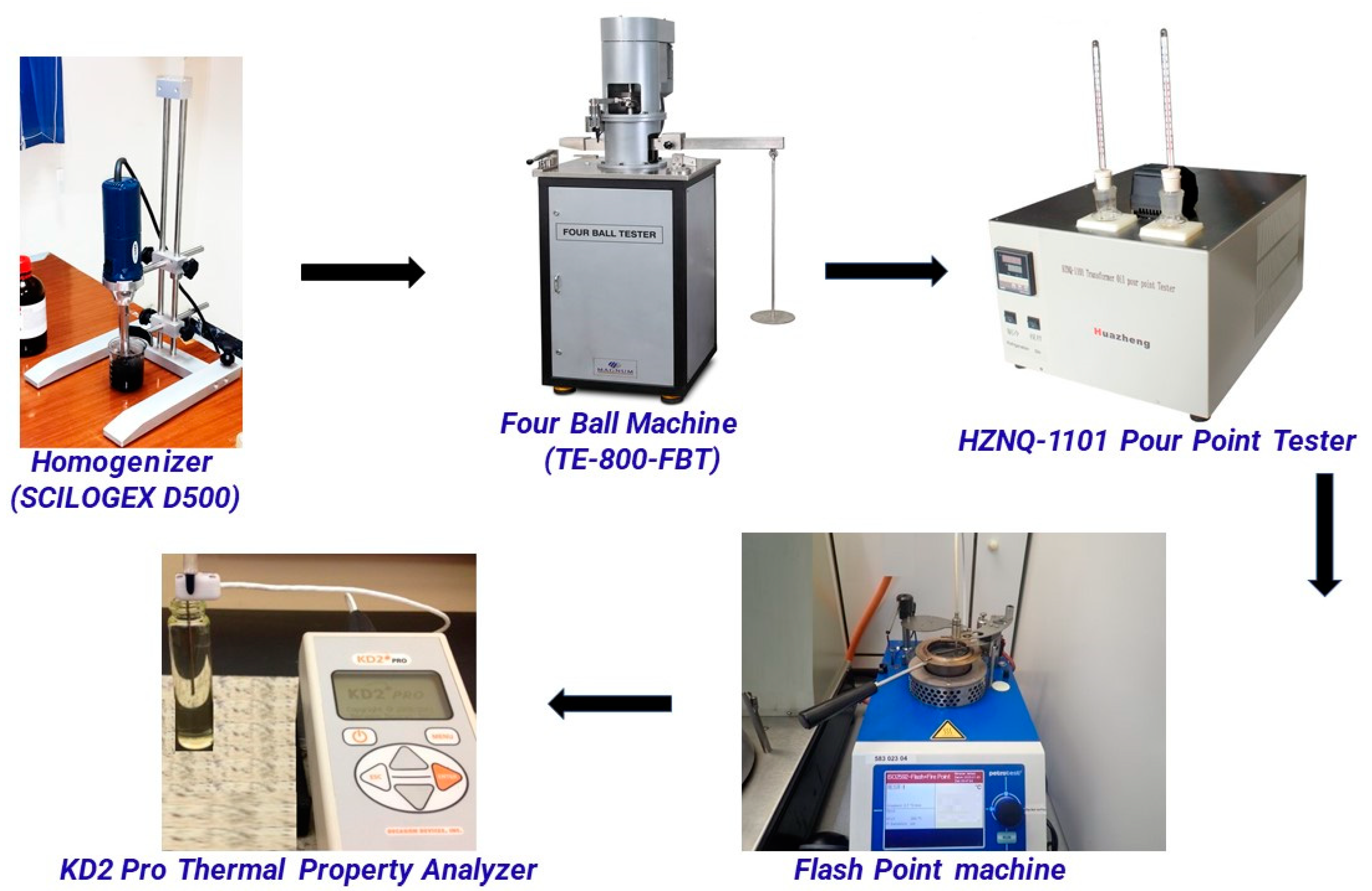

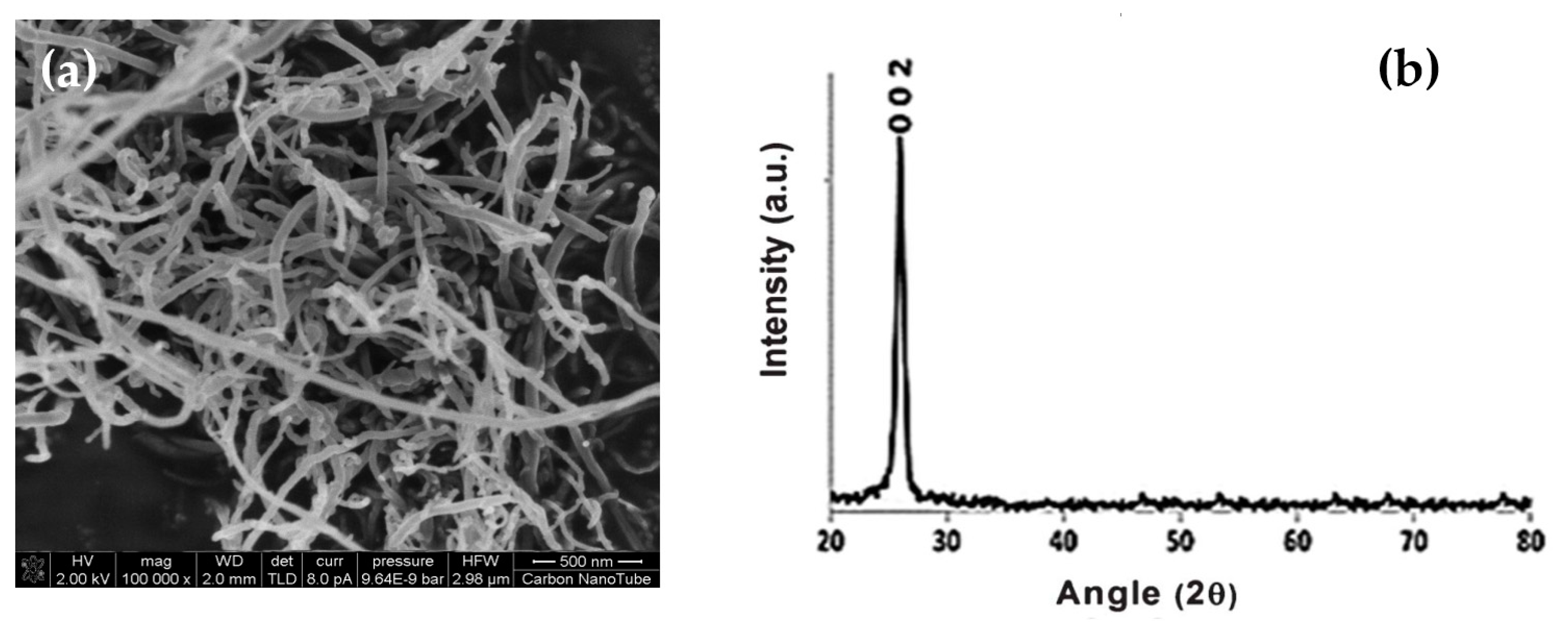

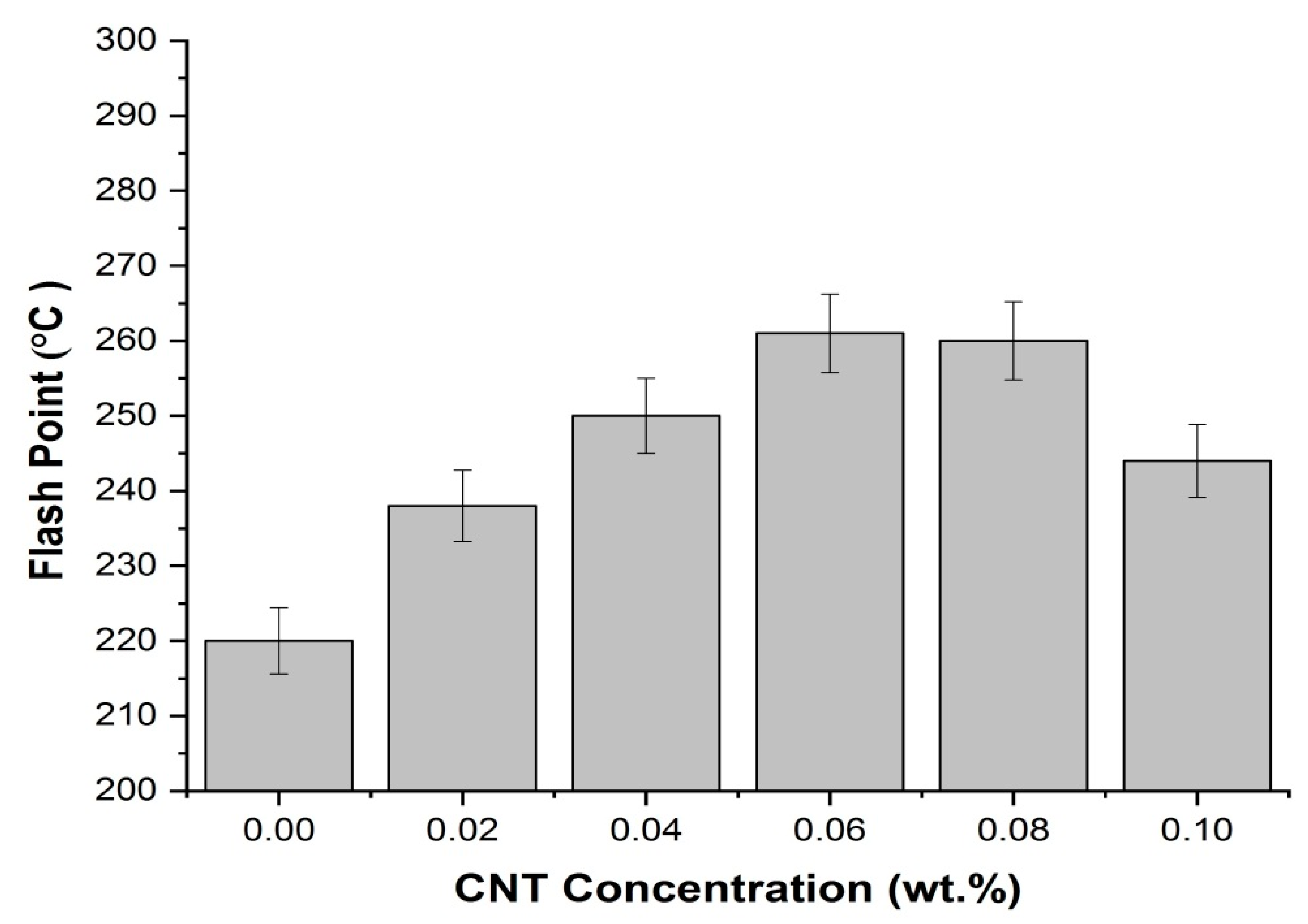

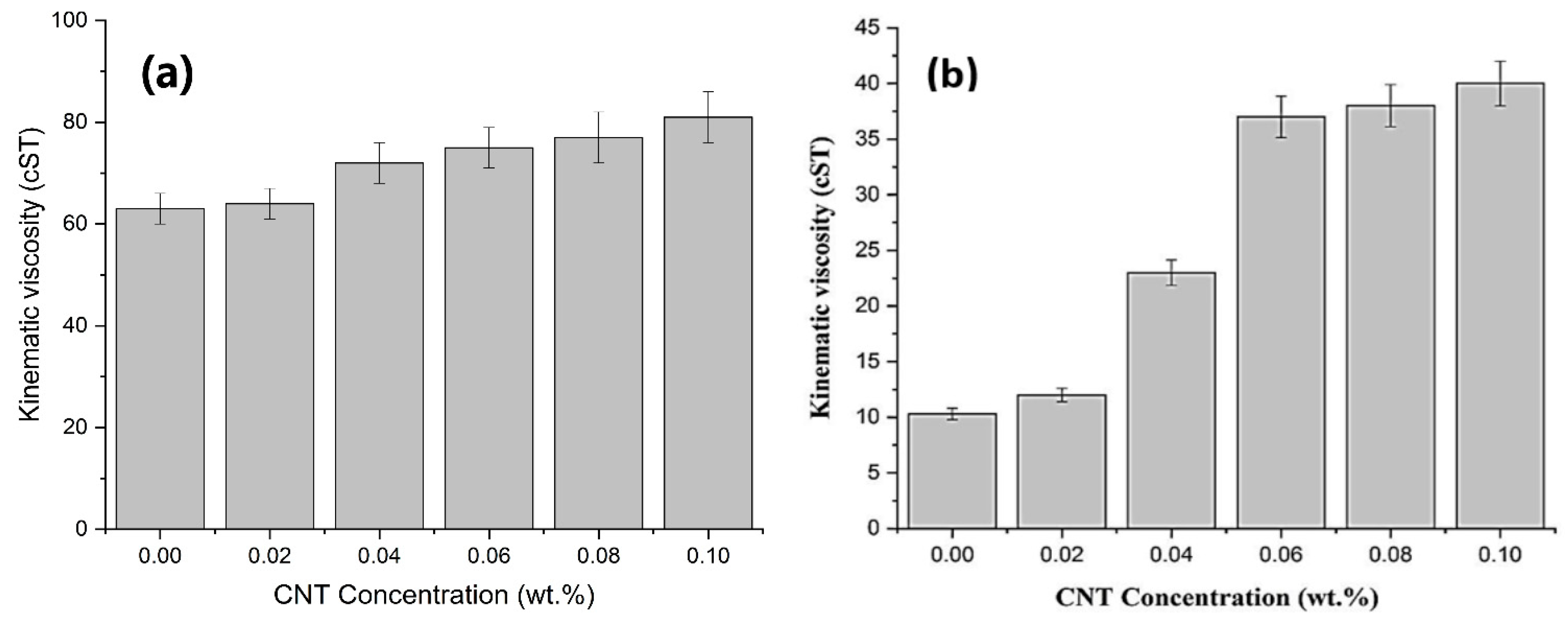
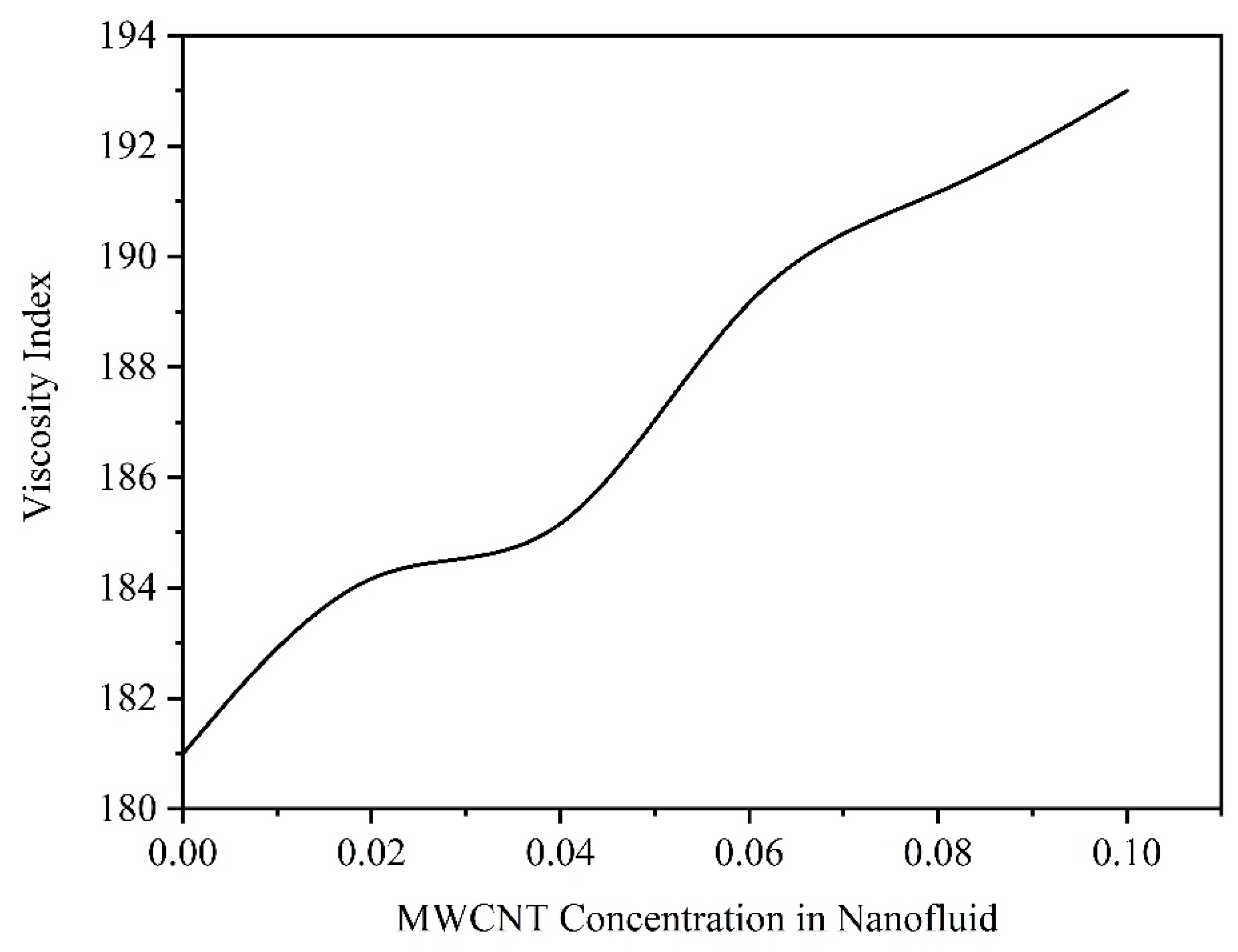
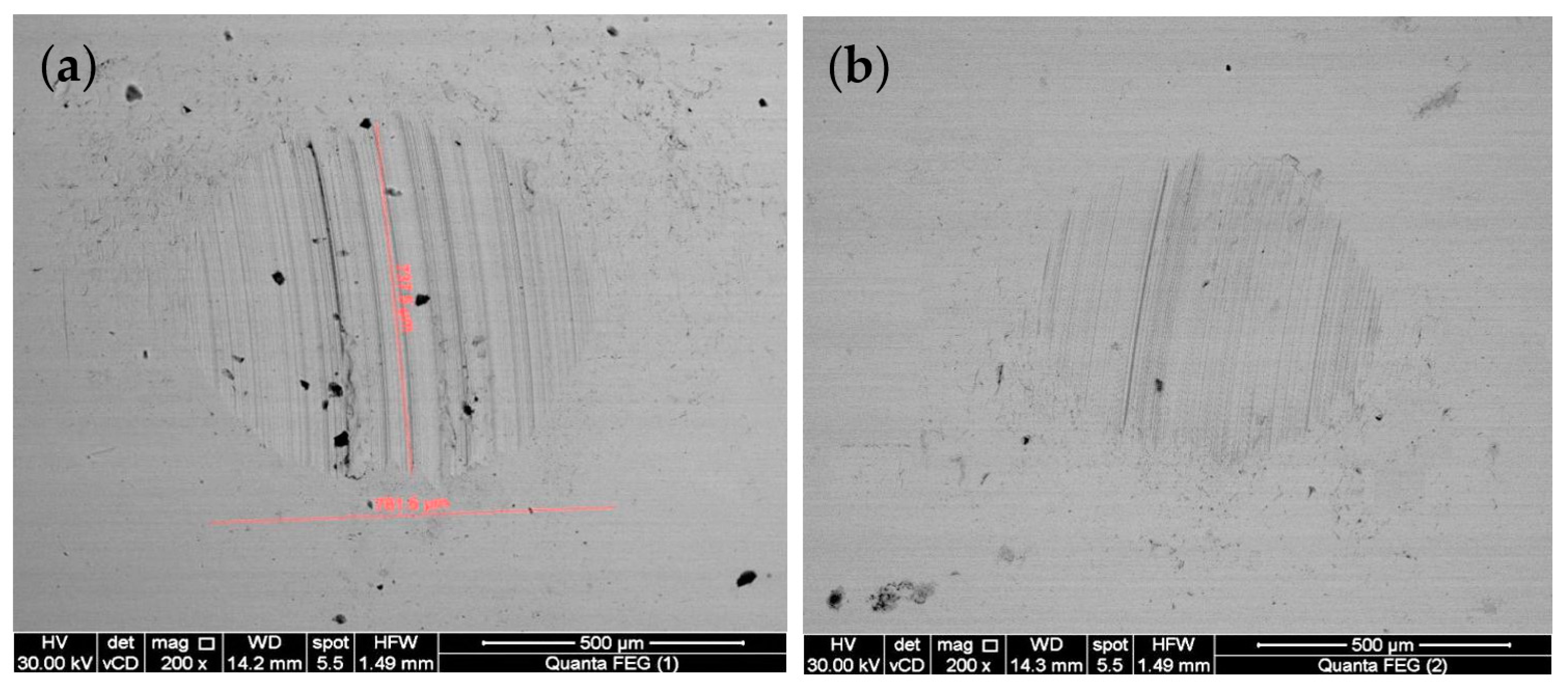
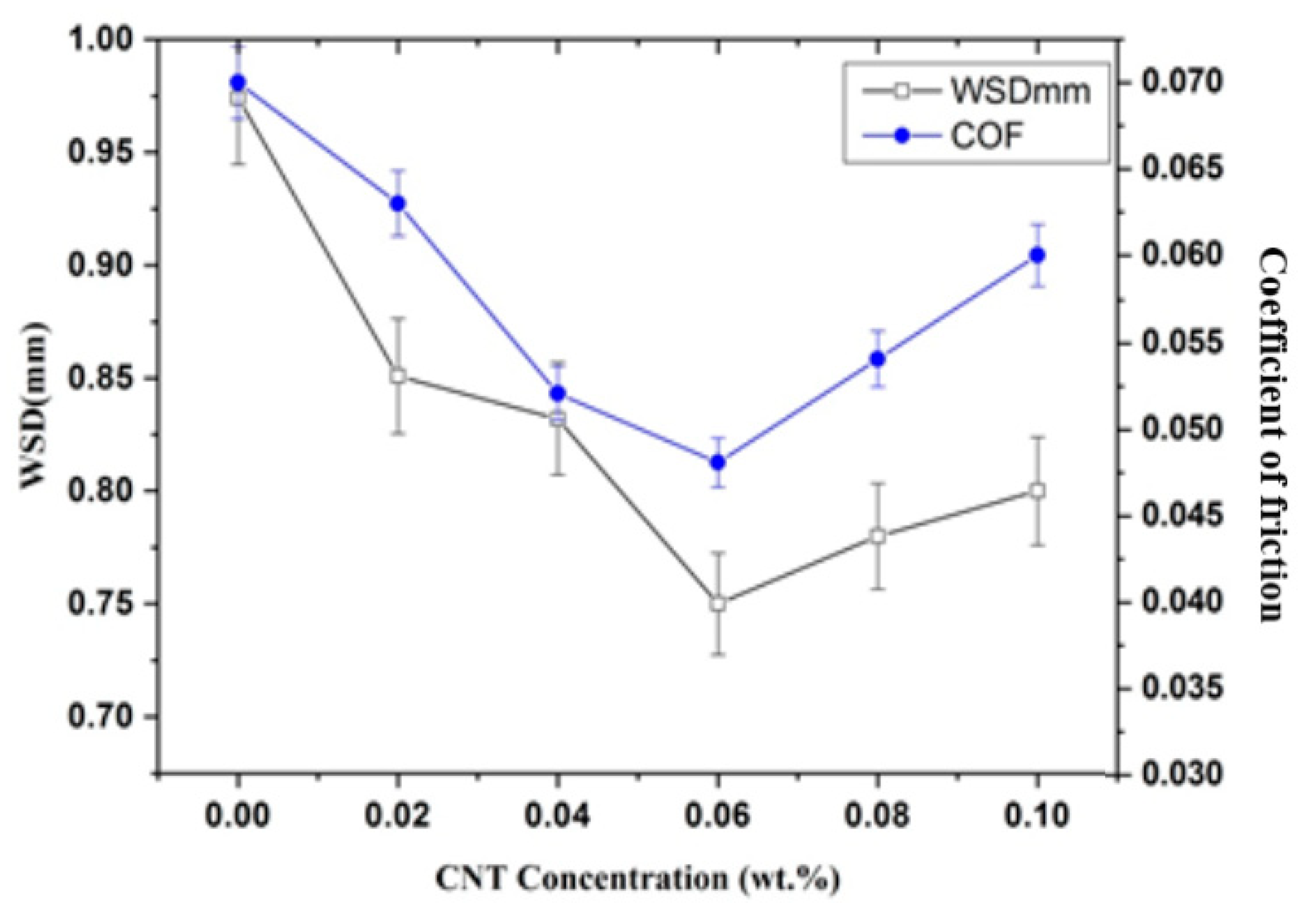
| Property | Value |
|---|---|
| Lubricant Grade | SAE 5w-30 |
| Pour Point, °C, ASTM D97 | −48 |
| Density @ 15 °C, kg/m3, ASTM D4052 | 848 |
| Kinematic Viscosity @ 40 °C mm2/s, ASTM D445 | 73.95 |
| Kinematic Viscosity @ 100 °C, mm2/s, ASTM D445 | 12.02 |
| Flash Point, Cleveland Open-Cup, °C, ASTM D92 | 220 |
Publisher’s Note: MDPI stays neutral with regard to jurisdictional claims in published maps and institutional affiliations. |
© 2021 by the authors. Licensee MDPI, Basel, Switzerland. This article is an open access article distributed under the terms and conditions of the Creative Commons Attribution (CC BY) license (https://creativecommons.org/licenses/by/4.0/).
Share and Cite
Kamel, B.M.; Tirth, V.; Algahtani, A.; Shiba, M.S.; Mobasher, A.; Hashish, H.A.; Dabees, S. Optimization of the Rheological Properties and Tribological Performance of SAE 5w-30 Base Oil with Added MWCNTs. Lubricants 2021, 9, 94. https://doi.org/10.3390/lubricants9090094
Kamel BM, Tirth V, Algahtani A, Shiba MS, Mobasher A, Hashish HA, Dabees S. Optimization of the Rheological Properties and Tribological Performance of SAE 5w-30 Base Oil with Added MWCNTs. Lubricants. 2021; 9(9):94. https://doi.org/10.3390/lubricants9090094
Chicago/Turabian StyleKamel, Bahaa M., Vineet Tirth, Ali Algahtani, Mohamed S. Shiba, Ahmed Mobasher, Hassan Abu Hashish, and Sameh Dabees. 2021. "Optimization of the Rheological Properties and Tribological Performance of SAE 5w-30 Base Oil with Added MWCNTs" Lubricants 9, no. 9: 94. https://doi.org/10.3390/lubricants9090094





